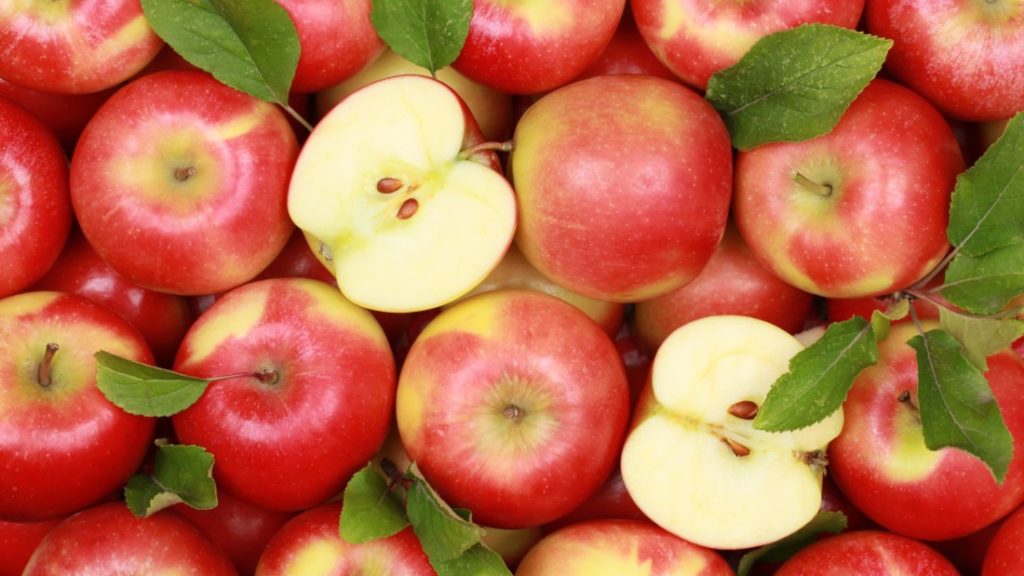Golden apples, poison apples, pie apples, Newton’s apple, and, of course, Johnny Appleseed…
Table of Contents
APPLES AND APPLE TREES
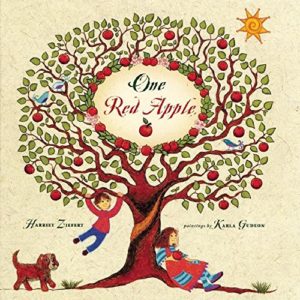 |
In Harriet Zeifert’s One Red Apple (Blue Apple Books, 2009), a big red apple is picked and taken to market, then bought and eaten by a little girl who throws away the core. A bird finishes off the leftovers and scatters the seeds, which take root, sprout, develop into saplings and mature trees, and then produce more red apples. The book ends with a thank-you to all the interconnected participants in the cycle of nature: birds, wind, sun, bees, and the Earth itself. For ages 4 and up. |
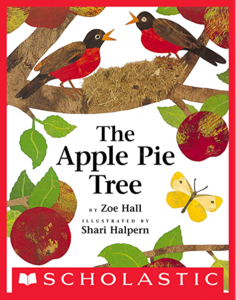 |
In Zoe Hall’s The Apple Pie Tree (Blue Sky Press, 1996) two little girls watch their backyard apple tree through the seasons of the year, from leafless winter to the buds and blossoms of spring when robins arrive to build a nest, to ripening fruit in summer – and finally, in fall, harvest and an apple pie. For ages 4-7. |
| An accompanying Apple Pie Tree Lesson Plan has suggestions for making a season chart and an apple web poster. | |
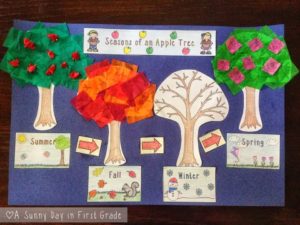 |
See Apple Tree Through the Seasons Craft Instructions for a four-seasons apple-tree project using construction paper, tissue paper, and thumb-print apples. |
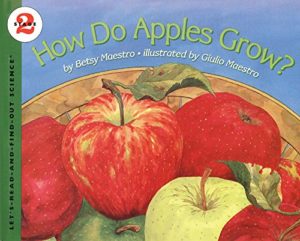 |
Betsy Maestro’s How Do Apples Grow? (HarperCollins, 2000) in the Let’s-Read-and-Find-Out Science series follows an apple from bud to fruit. For ages 4-7. |
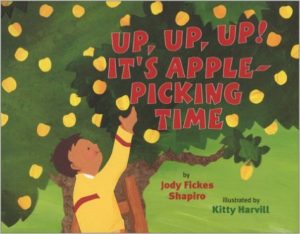
|
Jody Fickes Shapiro’s Up, Up, Up! It’s Apple-Picking Time (Holiday House, 2008) is a cheerful harvest tale, illustrated with bright paper collages, in which young Myles and Amber go to their grandparents’ orchard to help out at apple-picking time. They climb ladders and pick apples (“the size of softballs”) with wonderful names like Winesap, Arkansas Black, and Winter Banana; then they help sell the apples at a roadside stand; and finally there’s an intergenerational family celebration. Included is a recipe for baked apples. For ages 4-7. |
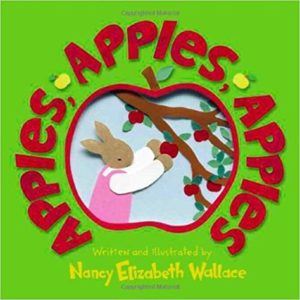
|
In Nancy Elizabeth Wallace’s Apples, Apples, Apples (Amazon Children’s Publishing, 2004) – which has great cut-paper illustrations – a family of bunnies spends a day picking fruit at an apple orchard while learning all about apples. Included are instructions for making apple prints and a recipe for applesauce. For ages 4-7. |
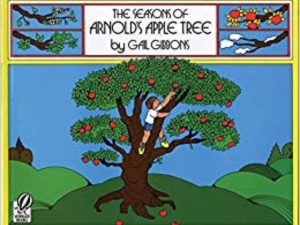 |
In Gail Gibbons’s The Seasons of Arnold’s Apple Tree (Sandpiper, 1998), the apple tree is Arnold’s special secret place. He builds a snow fort around it and hangs strings of popcorn on its branches for the birds in winter; in spring, he builds a swing; in summer, a treehouse; and in the fall he rakes leaves and picks apples. Included is a recipe for apple pie and an explanation of cider-making. For ages 4-7. |
| Apples and Seasons has a simple art project in which kids make a four-season picture of a changing apple tree using apple prints, plus several multidisciplinary lesson plans. | |
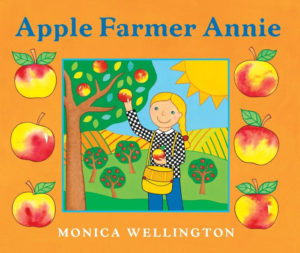
|
In Monica Wellington’s Apple Farmer Annie (Puffin, 2004), Annie has a spotted dog, a yellow-and-orange striped cat, and an apple orchard. Bright stylized illustrations follow Annie as she picks her apples, turns them into cider, applesauce, and muffins, and sells these at the farmer’s market. For ages 4-7. |
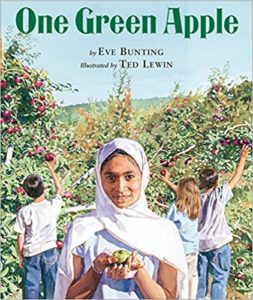
|
In Eve Bunting’s One Green Apple (Clarion, 2006), Farah, a young Muslim immigrant, is having a hard time adjusting to America. She’s not used to boys and girls sitting together; she struggles with English; and she’s the only person around to wear a dupatta or head scarf. In the fall, on a class trip to a cider mill, however, Farah begins to see the possibilities of life in her new land. The lesson is that in the same way many different kinds of apples blend together to make wonderful cider, different kinds of people interact to create good communities. A good discussion book for ages 5-9. |
| Also see IMMIGRANTS AND REFUGEES. |
A IS FOR APPLE PIE
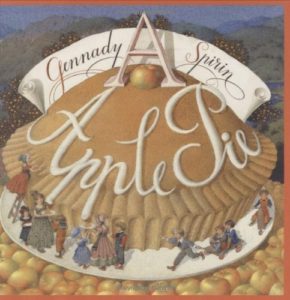
|
Gennady Spirin’s A Apple Pie (Philomel, 2005) is a lovely, intricately illustrated version of the traditional 17th-century children’s alphabet rhyme on the fate of an apple pie (“B bit it, C cut it, D dealt it…”). Spirin’s paintings are Victorian in theme: little girls in bonnets and sashes, boys in Dickensian collars, tin soldiers and hobbyhorses. For all ages. |
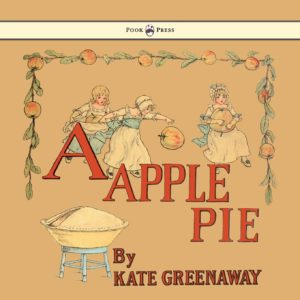 |
See Kate Greenaway’s classic illustrated version of A Apple Pie, originally published in 1886. And learn more about illustrator Kate Greenaway. |
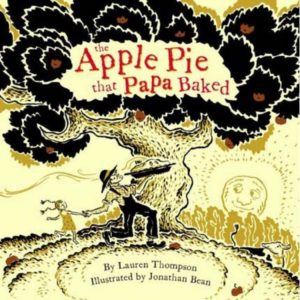
|
Lauren Thompson’s The Apple Pie That Papa Baked (Simon & Schuster Books for Young Readers, 2007) is a cumulative tale on the order of “This is the house that Jack built,” starting with the apples (“juicy and red, that went in the pie, warm and sweet, that Papa baked”) – and then moving back to apple tree, tree roots, rain, clouds, sky, and sun. Folk-art illustrations, in shades of black and brown, show Papa in overalls and his little daughter with long flying braids. For ages 3-6. |
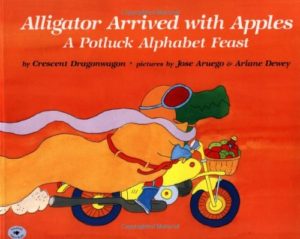
|
Crescent Dragonwagon’s Alligator Arrived with Apples (Aladdin, 1992) is a marvelous alphabetical Thanksgiving feast, to which Alligator (on a motorcycle) contributes apples and allspice, Bear follows with biscuits and butter, through Elephant (elderberry elixir), Koala (kohlrabi), and Zebra (zucchini). A delightful romp, complete with alphabetical animal place cards. For ages 4-7. |
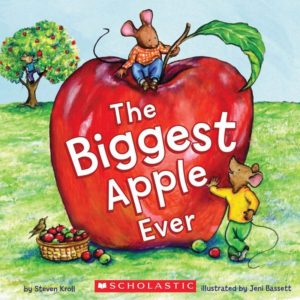
|
In Steven Kroll’s The Biggest Apple Ever (Cartwheel Books, 2011), Desmond, the country mouse, and Clayton, the town mouse – who in previous books have competed to come up with the biggest pumpkin, snowman, Christmas tree, and Valentine – vie to produce the biggest apple for a school-sponsored contest. As always, friendship and sharing triumph, and the book ends with a gigantic apple pie for all. For ages 4-8. |
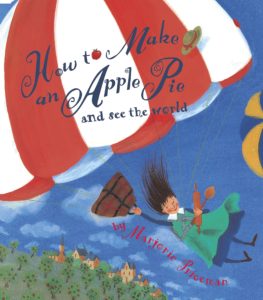
|
In Marjorie Priceman’s How to Make an Apple Pie and See the World (Dragonfly Books, 1996) a determined cook in a green pinafore finds that the local market is closed and so – what else? – grabs her carpetbag and sets off to collect the ingredients for her pie from points around the globe. First she heads to Italy, via steamship, for wheat for flour; later stops include France for a chicken (eggs), Sri Lanka for cinnamon, Jamaica for sugar cane, England for a cow (butter), and Vermont for apples. Finally a multicultural crowd of guests sits down to share the finished pie, and the book ends with a recipe. For ages 5-8. |
| How to Make an Apple Pie and See the World is a geography lesson to accompany the book. | |
| Or how about an apple pizza? See a recipe here. |
